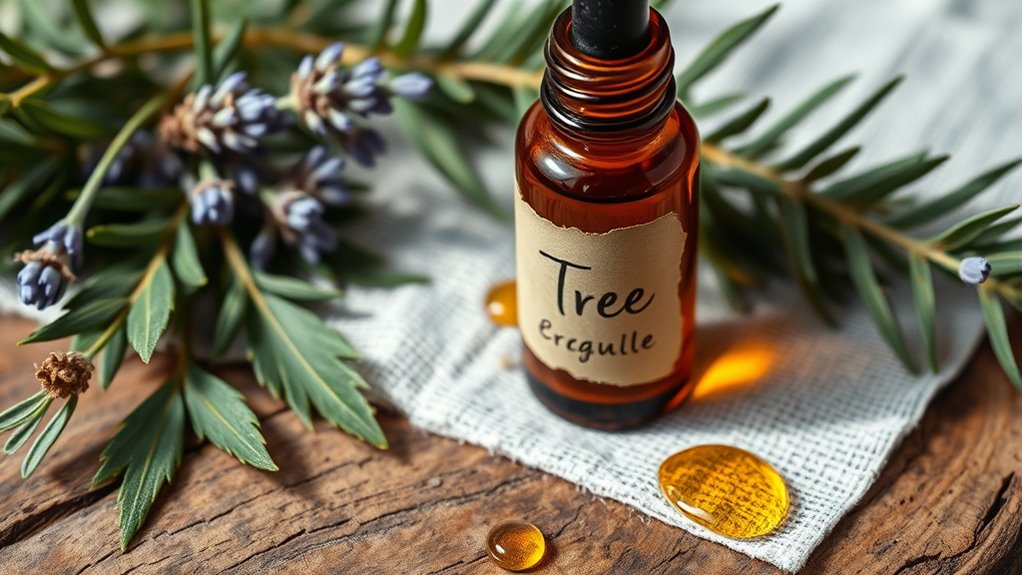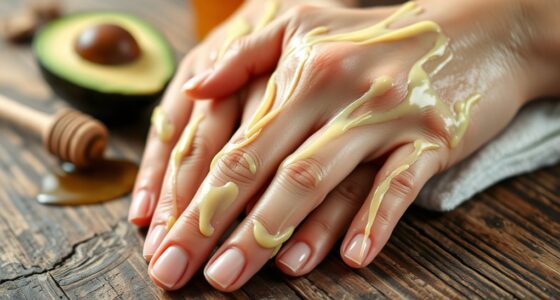For nail fungus, you can use essential oils like tea tree, lavender, oregano, and eucalyptus, which have natural antifungal and antimicrobial properties. Apply diluted oils directly to your affected nails with a clean cotton swab, and repeat twice daily. Soaking nails in warm water with these oils can boost their effectiveness. Be cautious and do a patch test first. Keep exploring to discover more tips on naturally treating nail fungus.
Key Takeaways
- Tea tree oil is highly effective against nail fungus due to its antifungal compound terpinen-4-ol.
- Other beneficial essential oils include lavender, oregano, and eucalyptus, which also possess antimicrobial properties.
- Diluting essential oils with carrier oils like coconut or jojoba reduces skin irritation during application.
- Regular, twice-daily application of oil blends can promote fungal infection recovery over time.
- Always perform patch tests and avoid using essential oils on broken or irritated skin to prevent adverse reactions.

Are essential oils a natural remedy for nail fungus? Many people wonder if these concentrated plant extracts can effectively combat stubborn fungal infections. The good news is that essential oils are widely recognized as natural remedies, offering antifungal properties that can help clear up nail fungus. Among the most popular options are essential oil blends designed specifically for fungal treatment, with tea tree oil being the standout. These oils contain compounds like terpinen-4-ol, which have proven antifungal and antimicrobial activities. Using essential oils for nail fungus is appealing because they are natural, generally safe when used properly, and can be incorporated into daily routines easily.
When you consider essential oils for this purpose, it’s important to choose the right blends. Tea tree oil, in particular, is renowned for its ability to destroy fungi and bacteria. Its broad-spectrum antimicrobial effects make it one of the most trusted natural remedies for skin and nail infections. To maximize their benefits, many people create essential oil blends by combining tea tree oil with other antifungal oils like lavender, oregano, or eucalyptus. These combinations often enhance the overall antifungal power and can hasten recovery. You can apply these blends directly to the affected nails using a clean cotton swab or dilute them with a carrier oil such as coconut or jojoba oil to reduce any potential irritation. Regular application, at least twice daily, can help break down the fungal infection and promote healthier nail growth.
Using essential oils as part of your nail fungus treatment does require consistency. It’s not a quick fix, but many find that incorporating natural remedies like essential oil blends into their routine yields noticeable improvements over time. Besides applying oils topically, you might also soak your nails in a warm water bath infused with a few drops of antifungal essential oils. This can help soften the affected nails and allow the oils to penetrate more deeply. Remember, while essential oils are powerful, they should be used with caution—perform a patch test first to check for sensitivities, and avoid applying them to broken or irritated skin. For persistent or severe infections, consulting a healthcare professional is always advisable.
Frequently Asked Questions
Can Essential Oils Completely Cure Nail Fungus Permanently?
You might wonder if essential oils can fully cure nail fungus permanently. While natural remedies like oil application can considerably improve symptoms and support healing, they often don’t guarantee a permanent cure on their own. Consistent use is key, but you should also consult a healthcare professional for proper diagnosis and treatment. Combining essential oils with other treatments offers the best chance for long-term relief from nail fungus.
Are Essential Oils Safe for Children or Pregnant Women?
Imagine discovering a natural remedy, but then wonder if it’s safe. When it comes to children safety and pregnancy precautions, you should be cautious with essential oils. Some oils, like tea tree, may cause irritation or adverse reactions. Always consult a healthcare provider before use, as not all oils are safe for children or during pregnancy. Your best bet is to choose gentle, proven options and follow proper dilution guidelines.
How Long Does It Typically Take to See Results?
You might wonder how long it takes to see visible improvements with treatment. Generally, the treatment timeline varies, but you can expect noticeable results within 4 to 8 weeks. Consistent application of the essential oil helps speed up the process. Keep in mind, patience is key, and sticking to your routine will give you the best chance for successful results as the nail fungus gradually clears.
Can Essential Oils Be Combined With Antifungal Medications?
Imagine you’re in a medieval apothecary, blending potent remedies. You can combine essential oils with antifungal medications for antifungal synergy, but you should do so carefully. Oil blending may enhance treatment, yet it’s wise to consult your healthcare provider first. This way, you guarantee safety and effectiveness, avoiding any potential interactions. Combining treatments thoughtfully could give your nail fungus fight a stronger, more effective edge.
Are There Any Allergic Reactions Associated With These Oils?
You might experience allergic reactions or skin sensitivities when using essential oils, especially if you’re prone to allergies. It’s important to do a patch test before applying oils more broadly. Some people develop redness, itching, or irritation. Always dilute essential oils properly and consult a healthcare professional if you notice any adverse reactions. Being cautious helps prevent allergic reactions and guarantees safe, effective use of these natural remedies.
Conclusion
Just like a skilled gardener weeds out unwanted pests, using essential oils like tea tree can help eliminate nail fungus naturally. One reader shared how applying tea tree oil daily cleared up her stubborn infection, restoring her confidence. Remember, consistency is key—think of it as tending a garden: patience and care lead to healthy, thriving nails. With the right approach, you can turn your nail health around, one drop at a time.








